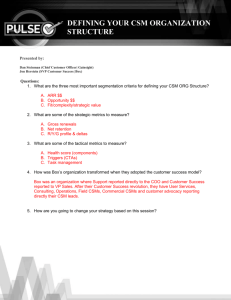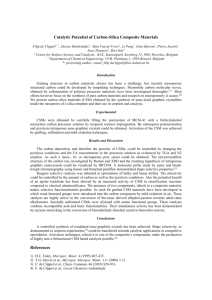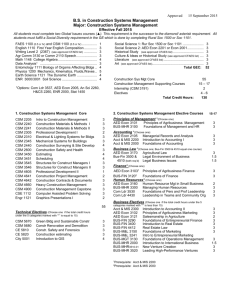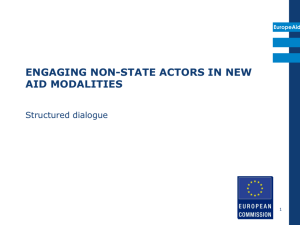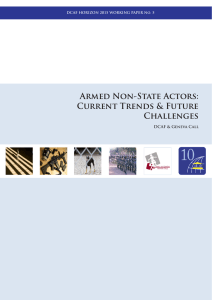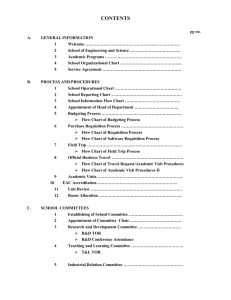Presentation - International Rail Safety Conference (IRSC)
advertisement
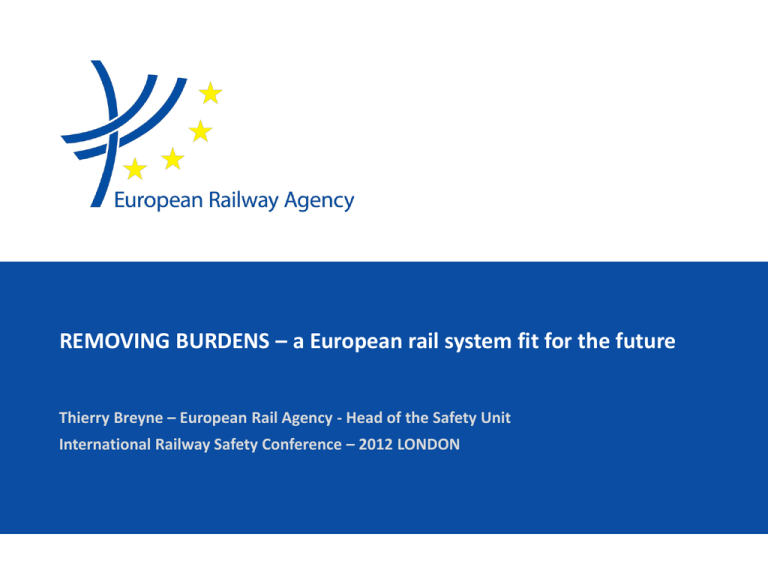
REMOVING BURDENS – a European rail system fit for the future Thierry Breyne – European Rail Agency - Head of the Safety Unit International Railway Safety Conference – 2012 LONDON Introduction Rail transport is a key necessity Rail transport is safe Décès de passagers par milliard de passager.km 2.5 EU-25 EU-15 2 1.5 1 0.5 2008 2006 2004 2002 2000 1998 1996 1994 1992 1990 1988 1986 1984 1982 1980 1978 1976 1974 1972 1970 1968 0 BUT for it to continue to maintain its competitive position, railways must become more efficient and effective 2 Existing legal framework Part A – is the acceptance of a RUs SMS. This is valid throughout the EU Part B - is the acceptance of RU’s capability to meet the specific requirements necessary for the safe operation of the relevant network. This is valid for the relevant Member State 3 Safety management system (SMS) SMSs provide the key tool for managing different operational requirements/risks Because: Allocate clear responsibilities Set risk management controls, which are monitored and reviewed Recognises the need to work together to deal with shared interfaces Learning and continuously improving Systematic approach to managing changes A coherent approach to managing the competence of staff and the different work environments 4 Flexible and proportionate legal framework RUs and IMs take forward their full responsibility for managing, controlling and monitoring risks of their operation Management & Control of Operational Activities using Processes & Rules SMS and CSMs The SMS TODAY Same in 2020! There is harmonised decision making and supervision of the safety of the sector by NSAs CSMs Result: it should be a small step change to the single safety certificate?? 5 Common safety methods CSM on risk assessment Related to change management – builds on the SMS CSM on monitoring Helps ensure that the SMS continues to be effective CSM on conformity assessment Harmonised assessment process CSM on supervision Sets out a clear structured way for NSAs to ensure that safety performance is managed without them taking on the responsibility 6 The problems •Incorrect implementation and application •Duplicate requirements by some Member States (re-checking what is in the Part A) •Onerous requirements by some Member States •Divergent interpretation of the assessment and acceptance of safety certificates •Problems with time and costs of issuing certificates Source ERFA 7 The solutions 1. A legal framework which sets out a proportionate, targeted and harmonised approach to managing safety across the EU 2. Correct implementation and application of the legal framework and collecting information on whether this has taken place 3. Improving compliance of the actors Result: it will be a small step change to the single safety certificate 8 Aim: Single safety certificate Simplified system with the single safety certificate But no major changes to the legal framework - consolidation The pre-conditions are in place RUs and IMs take forward their full responsibility for managing, controlling and monitoring risks of their operation CSM on risk assessment CSM on monitoring There is harmonised decision making and supervision of the safety of the sector by NSAs CSM on conformity assessment CSM on supervision COST Savings of between 50 to 100K Euros for an RU over a 5 year period 9 Achieving continous improvement Helping NSAs to move: FROM 17/07/2012 To InnoTrans 2012 planning 10 What the Agency will do • Review existing framework to ensure it is fit for purpose • Understand the system - collect and analysis data • Provide better targeted and simpler guidance • Develop training and educate • Work closely with our stakeholder to deliver this 17/07/2012 InnoTrans 2012 planning 11 Result: Single safety certificate Make the railway system work better by removing burdens and making a EU rail system fit for the future SINGLE SAFETY CERTIFICATE WILL: 1. 2. 3. SIMPLIFY REQUIREMENTS – One certificate valid throughout Europe based on the SMS and the RU controlling risks BE CHEAPER – because NSAs will not be duplicating what other NSAs do and requiring additional checks with no safety benefits PUT RESPONSIBILITY – where it should be; RUs managing & monitoring risks and NSAs supervising that that they do in co-operation with other NSAs The system is there and if correctly applied it is just a small step We make the railway system work better for society era.europa.eu 17/07/2012 InnoTrans 2012 planning 13
